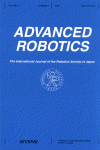
Mobile robot localization using a non-linear evolutionary filter
This article describes a localization system for autonomous mobile robot navigation in an indoor semi-structured environment. A peripheral ring of 24 ultrasonic sensors and a camera with a motorized zoom
on a pan-tilt platform are used to obtain the information required for the localization process. A non-linear filter based on a genetic algorithm as an emerging optimization method to search for optimal
positions is presented. The proposed algorithm is based upon an iterative extended Kalman filter (EKF), which utilizes matches between observed geometric beacons and a generic map of beacon locations and
the detection of artificial landmarks, to correct the position and orientation of the vehicle. No exhaustive map of the environment is provided to the mobile robot. It must work with a generic description
of the kinds of entities in the environment. The resulting self-localization module has been integrated successfully in a more complex navigation system based on a reactive architecture. Various experimental
results show the effectiveness of the presented algorithm, including a comparison with the EKF method.
Keywords: GENETIC ALGORITHMS; KALMAN FILTER; MOBILE ROBOTS; ULTRASONIC SENSORS; VISUAL LOCALIZATION
Document Type: Research Article
Publication date: 01 November 2002
- Access Key
- Free content
- Partial Free content
- New content
- Open access content
- Partial Open access content
- Subscribed content
- Partial Subscribed content
- Free trial content